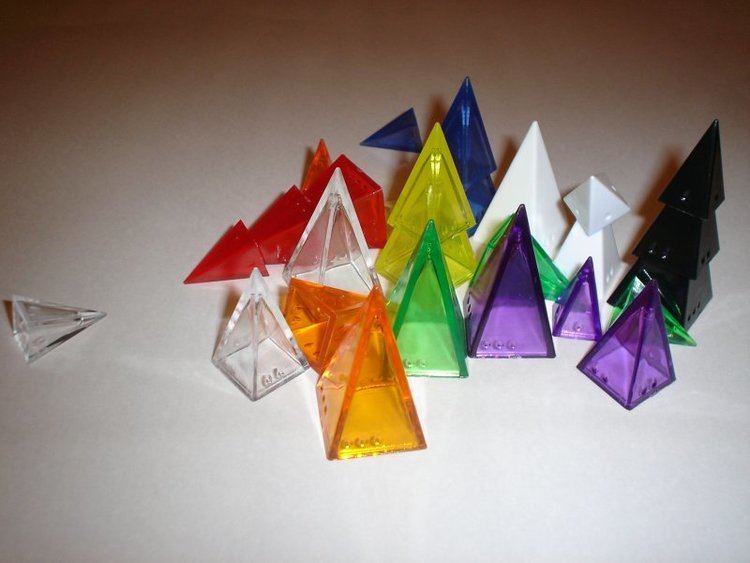Years active 1987-present | ||
 | ||
Other name(s) Icehouse pyramidsTreehouse piecesLooney Pyramids (official) Manufacturer(s) Grand Prix International Designer(s) John CooperAndrew Looney Publication date 1989; 28 years ago (1989) | ||
Icehouse pieces, or icehouse pyramids, Treehouse pieces and officially Looney Pyramids, are nestable and stackable pyramid-shaped gaming pieces and a game system. The game system was invented by Andrew Looney and John Cooper in 1987, originally for use in the game of Icehouse.
Contents
History
Andrew Looney in 1987 penned a sci-fi short story, "Ice House", that included a game called Icehouse, an ancient Martian game. Readers of the short story requested to learn how to play the game. Thus actual rules were invented for Icehouse, then plastic pyramid pieces were made to play the game. The first commercially available set were solid non-stackable pyramids released in 1989 with only 100 set made. The pieces were made from resin in his apartment which upset the landlord. After several years, Looney shut down Icehouse Games, Inc. and soon started another gaming company, Looney Laboratories, 1996.
Additional games beyond Icehouse were created including Martian Chess, Zendo, and Homeworlds. Looney then created the IceTowers game which used stacking pyramids leading to a change in the pyramid pieces' specification for stacking.
In 2001, Icehouse: The Martian Chess Set won the Origins Award for Best Abstract Board Game of 2000. In 2004, the Zendo boxed set won Best Abstract Board Game of 2003, In 2005 the set won the Mensa Select Game Award., while in 2007, Treehouse won the Origins Award for Best Board Game of 2006.
Looney Labs relaunched the Icehouse pieces as "Looney Pyramids" with new packaging in its IceDice set in June 2011 followed by Pink Hijinks in December 2012. By 2013, the IcehouseGames.org website listed 400 games playable with icehouse pyramids.
In April 2016, Looney Labs launched a Kickstarter campaign for a new boxed pyramid set, Pyramid Arcade. The campaign was highly successful, raising nearly five times the original goal of $33,000.
Description
The pieces are four sided pyramids that can nest and stack with pipping from 1 to 3 at the base. A group of three pyramids of each size is called a "trio." Each "stash" or set of Icehouse pieces consists of five trios, or fifteen pyramids (variously called pieces, pyramids, or minions) of the same color and five of each three sizes: five large 3-point pyramids (called "queens" in some games), five medium 2-point pyramids (sometimes called "drones"), and five small 1-point pyramids (or "pawns"). The stacked and nested feature is not used in the original Icehouse game, but is taken advantage of in some of the other Icehouse-based games listed below.
Icehouse pieces were, for many years, sold as tubes containing one stash of durable crystal-look plastic pieces in one of ten available colors (though cyan was only available through their promotional program or as part of the Ice Towers set). There was also a less expensive starter set called Origami Icehouse (later called Paper Icehouse), made of cardstock in four colors, which one punched out and folded into the pyramid shapes. In 2006, Looney Labs began selling Icehouse pieces as Treehouse sets, which are multicolored sets of 15 pyramids: five colors, each color having one each of the three sizes. Looney Labs has also sold boxed sets for Zendo and IceTowers; the latter contained cyan pieces. The Icehouse website also has instructions for making your own pieces. Looney Labs has licensed Crystal Caste to make regulation-sized Icehouse pieces out of semiprecious stone. Beginning with its Looney Pyramids relaunch set, IceDice, the sets are packaged in pyramid shaped nylon zipper bag.
Releases
Games
Icehouse pieces can be used to play many different abstract strategy games. Most games need at least two colors, and some require other readily-available equipment such as glass stones or a checkerboard.
Score-keeping
Icehouse pieces can also be used as a score-keeping device or counter for non-icehouse games. For example, when scoring a Cosmic Wimpout game, a small pyramid would be worth five points, a medium pyramid worth twenty-five points, and a large pyramid one-hundred; the goal being to collect five of the large pieces (for the 500 point standard game). They could be use instead of poker chips, the denominations would be determined by size rather than color (smalls are worth one, mediums worth five, and larges valued at twenty-five, for example).
